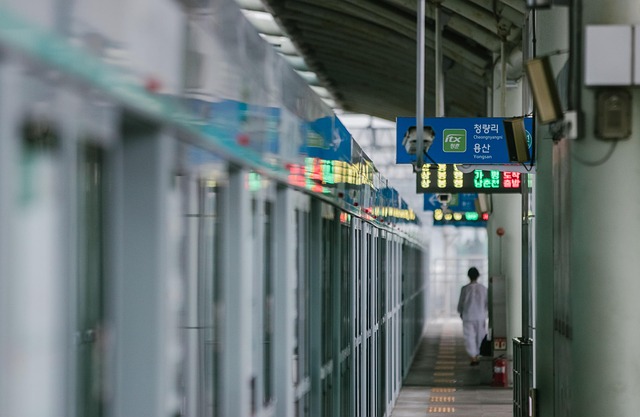Construction sites face significant challenges in navigating complex underground utility lines, including water, gas, electricity, and communication cables. Utility line mapping, using advanced technologies like ground-penetrating radar (GPR) and GPS devices, is crucial for identifying these lines accurately. This proactive approach enhances safety by minimizing damage risks to vital services, reducing costly delays, service disruptions, and environmental hazards. Digital transformation through utility line mapping streamlines project planning, enables efficient route planning, fosters communication, reduces liability, and promotes timely completion while adhering to 'Dig Safe' practices.
In the bustling construction industry, ensuring safety is paramount. With increasing project complexities, navigating beneath-ground utility lines has emerged as a significant challenge. This article explores how reliable utility line mapping can transform construction sites into safer environments. We delve into the challenges of traditional site navigation, highlighting the critical role of utility line mapping in preventing accidents and disruptions. Furthermore, we discuss implementation strategies, benefits, and glimpse into future trends driven by advanced technologies for enhanced construction safety.
Understanding the Challenges of Construction Sites
Construction sites present unique challenges that demand meticulous attention to detail and robust safety measures. One of the primary obstacles is navigating the complex web of underground utility lines, which can include water, gas, electricity, and communication cables. The risk of damaging these critical infrastructure components during excavation or construction activities is significant, potentially leading to costly delays, service disruptions, and even environmental hazards.
Reliable utility maps play a pivotal role in mitigating these challenges through precise identification and documentation of underground utilities. By utilizing advanced mapping technologies and data collection methods, such as ground-penetrating radar (GPR) and GPS-enabled devices, construction teams can gain accurate insights into the location, depth, and type of utility lines before beginning any work. This proactive approach enhances safety by minimizing the risk of accidents and ensuring that construction activities are carried out with the utmost care and consideration for underlying utilities.
The Role of Utility Line Mapping in Safety
Utility line mapping plays a pivotal role in enhancing construction site safety, serving as a critical tool for avoiding potential hazards and catastrophic failures. By meticulously detailing the location and depth of underground utilities, including water, gas, electricity, and telecommunications lines, these maps provide construction teams with invaluable insights into the ground’s hidden landscape. Armed with this knowledge, workers can navigate sites more safely, reducing the risk of accidental damage or disruption to vital services.
This practice is particularly crucial in urban areas where construction projects often involve complex and densely packed underground infrastructure. Reliable utility line maps enable better planning and coordination, ensuring that excavation activities are conducted with precision and care. Such maps also facilitate efficient communication among various stakeholders, including contractors, utility companies, and local authorities, fostering a culture of safety and collaboration.
Implementation and Benefits of Reliable Maps
The implementation of reliable utility maps is a game-changer in construction safety. By accurately depicting underground and overhead utility lines, these maps serve as a critical tool for navigating construction sites. Workers can avoid costly damage to essential services by identifying and understanding the layout of pipes, cables, and wires before excavation or installation begins. This proactive approach significantly reduces safety risks, including electrocution, gas leaks, and service disruptions.
Reliable utility mapping offers numerous benefits beyond enhanced safety. It streamlines project planning, allowing for efficient route planning and reduced delays. Contractors can coordinate with utility providers to mark and locate lines, ensuring safe and informed digging, which is a key component of the ‘Dig Safe’ practices advocated by many countries. This meticulous process fosters better communication between stakeholders, reduces liability, and promotes the timely completion of construction projects.
Future Trends: Advanced Technologies for Enhanced Safety
The future of construction safety lies in embracing advanced technologies, particularly in the realm of utility line mapping. As the industry evolves, digital transformation plays a pivotal role in enhancing site safety and efficiency. One such innovation is the implementation of precise utility line mapping systems that utilize cutting-edge GPS technology and 3D modeling. These tools enable construction professionals to create comprehensive digital representations of underground utilities, providing a clear and accurate picture of the hidden infrastructure beneath their feet.
By integrating real-time data with advanced visualization techniques, workers can navigate hazardous areas with enhanced awareness. This technology goes beyond traditional paper maps, offering a dynamic and interactive platform that improves communication and decision-making processes. With the ability to identify and mark utility lines, construction teams can minimize the risk of accidental damage or disruptions during excavation, ultimately leading to safer working conditions and project delays avoided.
Reliable utility maps, through advanced utility line mapping technologies, are transforming construction safety. By providing accurate and up-to-date information about underground utilities, these maps significantly reduce excavation risks and prevent costly damage. As the construction industry evolves, integrating these innovative tools will be key to enhancing site safety, streamlining operations, and ensuring project success. Utility line mapping is not just a trend; it’s a necessary step towards a more efficient, secure, and sustainable building future.
